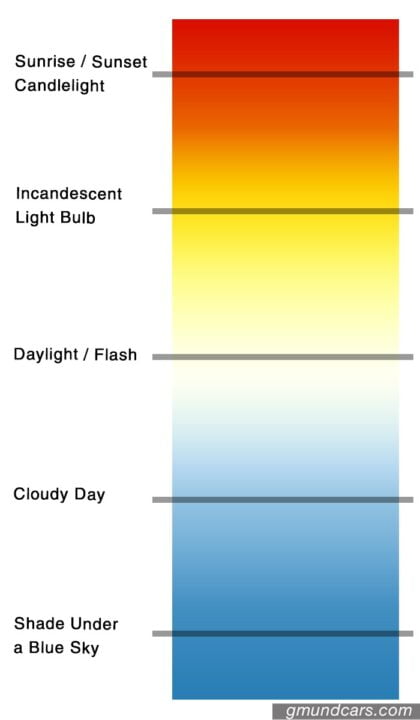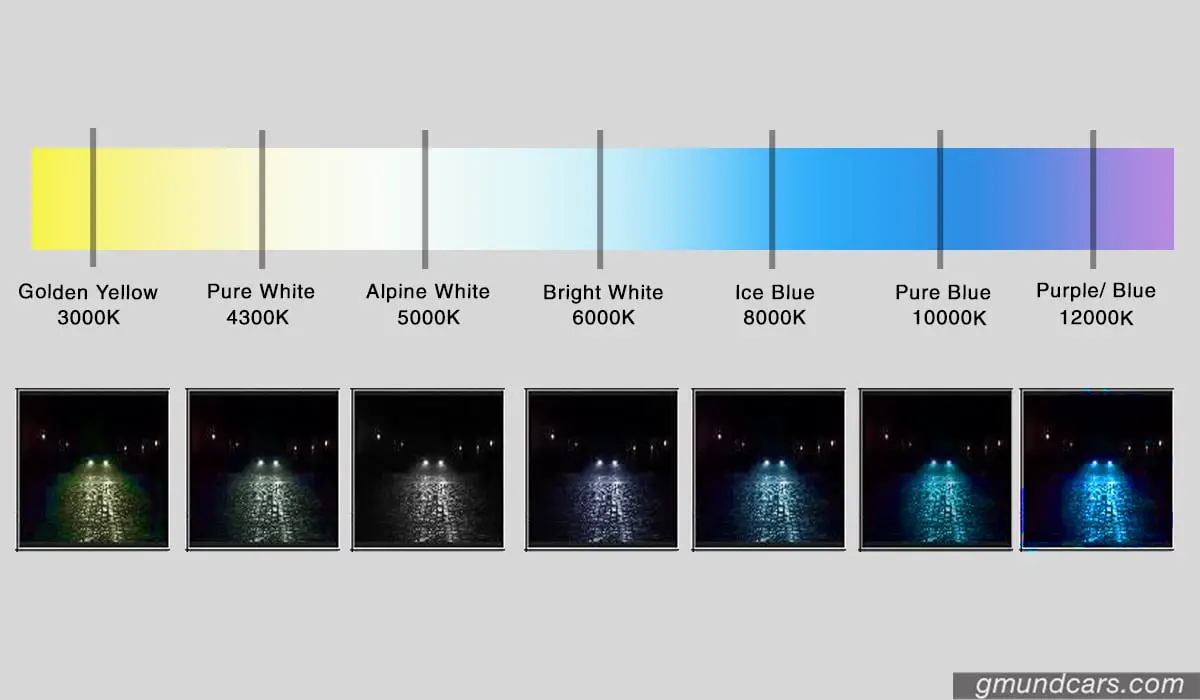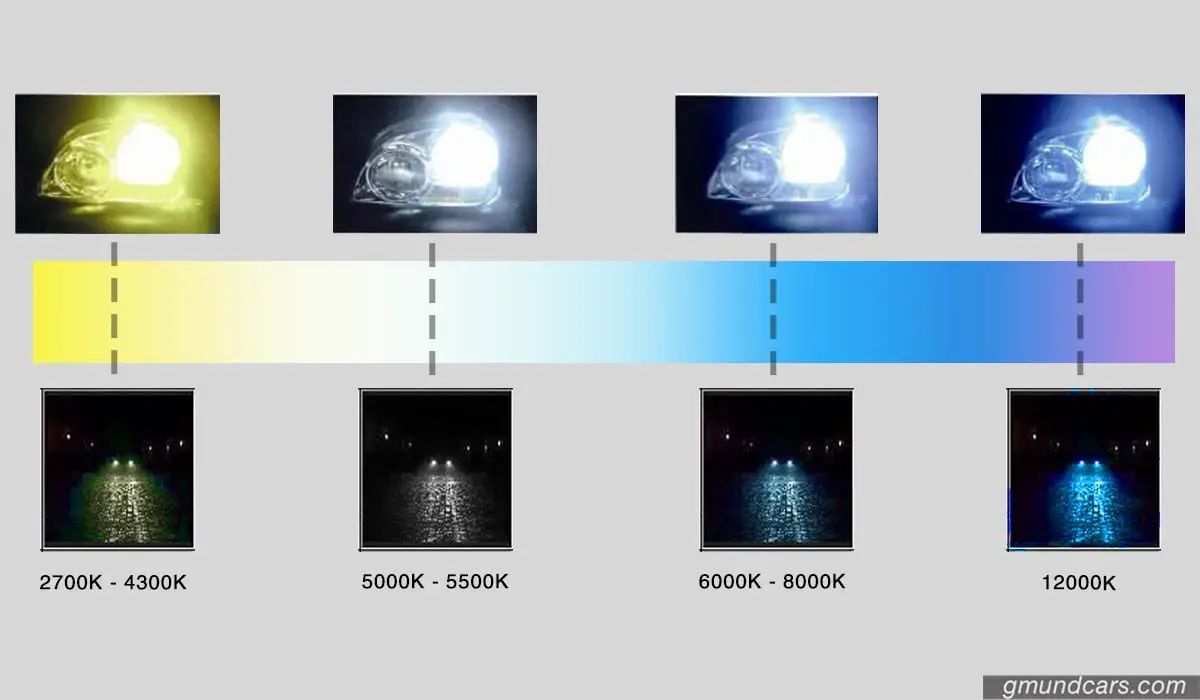That said, it must be stressed that HID or LED bulbs possess varying temperatures. Knowing this, we decided to save you the stress of trying out different bulbs before finding what you need. Once you know each HID or LED bulb’s purpose, you can tell its temperature firsthand without any examination. No stress!
Take a look at our HID and LED colour temperature chart to find the best solution for your need.
| Best For | HID bulb temperature | LED bulb temperature |
|---|---|---|
| Brightest light Output | 4,300K to 6,000K | 5,500K-6,000K |
| Nighttime visibility | 5,000K | 5,500K |
| Driving in rain, fog, or snow | 3,000K | 3,000K-4,300K |
| Stylish look | 8,000K to 12,000K | 8,000K to 12,000K |
| Stylish look & night visibility (balance) | 6,000K | 6,000K |
| Imitating stock lighting (stock halogen ) | 3,000K | 2,700K-4,300K |
HID headlight color guide
HID color temperature measurement
First, let’s talk you through the colour guide for the High-Intensity Discharge (HID) headlight.
Here’s the deal: HID bulbs come in different colours. It’s only right that you acquaint yourself with the colours before buying one. HID bulbs possess varying colour temperatures. These temperatures are dependent on how the human eye sees the HID colour spectrum. They can be measured in Kelvin.

The brightness of an HID bulb is inversely proportional to the colour temperature. Put differently, the higher the colour temperature, the lesser the brightness of the HID bulb. For example, at different temperatures, the light emitted could range from red to white to purple.
You probably didn’t know this, but now you do. Want to know about colour temperature measurement? Keep reading.
What is Kelvin?
As stated above, the colour temperature is measured in Kelvin. So, what is Kelvin?
Kelvin is the fundamental unit of thermodynamic or colour temperature. It is used to measure the colour of the light emitted from a bulb.
The most common HID kits on the market fall within the colour range of 3,000K to 20,000K. The HID colours 6,000K, and 8,000K are the more utilized options from this wide colour range than others.
It is worth noting that the higher the Kelvin of a kit, the bluer the light output is. You must also know that a higher Kelvin number does not mean an increased light brightness.
Light output
Light output is the brightness or the amount of light emitted by a light source or bulb. It can be measured in lux or lumen (lm).
Before jumping into the market to get a headlight, you must have this knowledge of lumen. Here’s why: The brightness of a bulb is directly connected to the lumen. This means that the more the lumen, the brighter the light and vice versa.
Headlight temperature vs. Light output
Temperature and light output play important roles in your selection of bulbs. While temperature impacts the colour of light produced by a bulb, light Output focuses on the bulb’s brightness.
Kelvin vs. Lumen
First, let’s throw the assumption that there is a correlation between Kelvin and Lumen out of the window. There are only key differences between Kelvin and Lumen and no correlation. This is an undisputed fact.
If there were any correlation between them, we wouldn’t have bulbs with high Kelvin and low Lumen. Or have existing bulbs with similar lumen but varying Kelvin measurements. Amazed, right? That’s the nature of the beast.
With this newly acquired knowledge, you already have an edge. Nonetheless, there are still some other essentials you need to be equipped with. Let’s dive deeper.
Warm vs. Cool color
Now, picture yourself wearing a warm or cool coloured outfit sun-kissed on a beautiful summer morning. You feel confident! It’s going to be a good day. You would agree that you won’t get this exact feeling wearing a harsh coloured outfit.
The same principle applies to headlights but from a different perspective. Here’s the point: Colors are essential in your choice of headlights. After a quick survey, we discovered most chose yellow and red as warmer colours. And purple, blue, and white as cool colours. Nevertheless, when choosing a headlight, your perception of colours has to be set aside. What matters is how well the colour you pick can help you see on the road.
Going for your favourite colour without assurance of better vision at night would be you throwing caution to the wind. Bet you won’t want to encounter this after your last headlight experience. Hence, you need to understand headlights and find out the best for you. HID bulbs are divided into two colour categories: warm and cool.
Let’s break it down for you.

- Warm Colors – These are colors with a lower Kelvin rating and fall in the red to the white color range. They also include the color orange and yellow. Here’s an example: 4,300K is classified as a warm color, and its light output is yellow or white. Warm colors produce brighter lights.
- Cool Colors – These colors possess a higher Kelvin rating. They include Indigo shades, bluish whites, and blues. A perfect example is 10,000K, which produces fewer bright lights.
HID Color Chart

Every HID kit you would see on the market has its colour temperature ranking in Kelvin. This serves as a determinant for the colour of the light emitted. For instance, the lower numbers tend to be yellow, while the higher numbers give deeper blue colours.
There’s a general rule for colours you need to know:
The colour on the lower and higher extremities is often used for style. Colour near the middle of the spectrum is best for nighttime visibility (and style as well).
There’s more to this than meets the eye. Keep scrolling.
Which is the brightest color for HID?

Torchbeam D1S HID

Marsauto D3S HID

DMEX D2S HID
If you’re searching for the brightest colour for HID, look no further than the lower-middle end of the spectrum. It falls between the range of 4,300K to 6,000K. Check this color chart for more clarity.
| Temperature (Kevin) | Color | Light Output (lumen) |
|---|---|---|
| 3,000K | Golden Yellow ( 95 %Yellow, 5% white) | 3,200lm |
| 4,300K | Yellow-White (80 %white and 20 % yellow) | 3,200 lm |
| 5,000K | Bright White (100 %white) | 3,000 lm |
| 6,000K | Alpine White ( 90 %white, 10 % Blue) | 2,800 lm |
| 8,000K | Ice Blue (70% white, 30% blue) | 2,300 lm |
| 10,000K | Pure Blue (95% blue, 5% purple | 2,100 lm |
| 12,000K | Purple ( 100%) | 1,800 lm |
Many individuals believe that a higher bulb temperature will yield a brighter light, but this is not true. And this colour chart is enough proof to rectify this notion.
After taking a good look at the chart, you definitely should have questions. One of which is why 3,000K and 4,300K have higher lumen but cannot produce brighter lights than 5,000K and 6,000K. The answer revolves around balance.
Here’s what we mean: At the temperature range 5,000K – 6,000K, there’s an outstanding balance between the appearance and light output. At this point, the bulb looks whiter and brighter than any halogen bulb.
Along with colour temperature, power also plays a role in your choice of bulbs. Power is measured in Watts. The most utilized are the 35W and 55W. So, if you yearn for maximum brightness for HID, you should get yourself a bulb with 55W and 5,000K. You can never go wrong with a white bulb. It’s the best choice.
Note: For HID over 10,000K, it may be illegal in some states. Please check your law.
HID 5,000K vs. 6,000K comparison
Besides 5,000K and 6,000K producing the brightest lights, it’s also the best range in the colour spectrum for human eyes. However, they possess specific distinctions. Take a look at our 5,000K and 6,000K comparison chart.
| Feature | 5,000K | 6,000K |
|---|---|---|
| Color description | Pure White | Crystal White ( white and blue ) |
| Comparable light | Clear sunlight (midday ) | Overcast |
| Compatibility to people’s eyes | Higher | Lower |
| Aesthetic look | Neutral look | Exotic aftermarket looks |
We want the best for you. That’s why we have done the research and brought to you the colour temperature that offers the brightest lights. To be honest, both are amazing options. But, you know where your interest lies. Make your pick and say goodbye to your headlight struggles today!
Read more: 5000K Vs. 6000K Vs. 8000K: Which bulb suits you best?
Choose the best color for my LED headlight
So, you want to get yourself a LED headlight? Not to worry, you are in good hands. Let’s help you make the best colour choice.
To begin with, you need to know that LED produces colour differently from HID or Halogen. HID uses noble gases; Halogen uses a vacuum, and LED uses solid matter to produce colour or light. The colours produced by a LED bulb ranges from yellow to Purple. Want to know how this works? You are just a scroll away.

Fahren H11/H9/H8 LED

SEALIGHT H11

BEAMTECH H11 LED
Read more: Best Fahren LED headlights review
LED headlight color chart
The common colours for a LED headlight range from yellow, white to blue, and purple. For more details, look at this headlight color chart.

| Color | Equivalent Color | Temperature (K) | Detailed color |
|---|---|---|---|
| Yellow | Stock halogen bulb | 2,700K-4,300K | 90% yellow, 10% White |
| White | Natural sunlight | 5,000K-5,500K | 100% white |
| Blue | Ocean blue | 6,000K-8,000K | 60% white, 40% blue |
| Purple | Dark violet | 12,000K | 90% Purple, 10% white |
White – They produce a colour that shares semblance with the sunlight. White colours are better road illuminators at night than yellow lights. You can rest assured to drive safely with a white LED at night.
Blue – They are new and pleasing to the eye but are not the right choice for road illumination at night. Worse yet, they are useless in rain, fog, or snow.
Purple – They offer way more aesthetic value than they do illuminate roads at night.
Which LED headlight color is brightest?
To get the best from the different LED bulbs at different temperatures, you need to combine them with power. And the most popular are the 25W, 35W, and 45W. You want the best headlight. A combination of a white headlight and a 45W is perfect for safety, quality, and brightness.
Conclusion
Finding the best color for your headlight depends solely on the purpose you need it to serve. It could have been quite tasking finding it yourself, but you found us. So, for safety, quality, brightness, the best for HID is the 55W and 5,000K. The best for LED is the 45W and 5,000K – 5,500K.
Get yourself the best HID or LED headlight you deserve. Don’t hold back. Do it NOW!